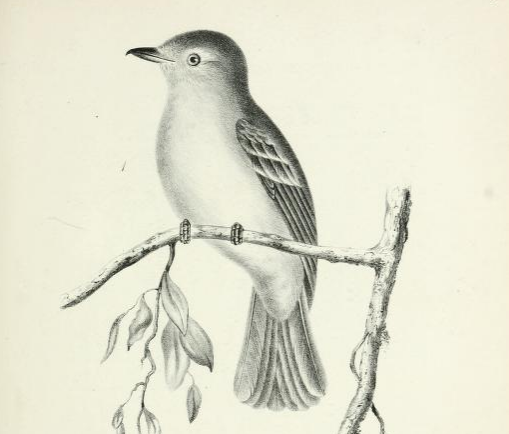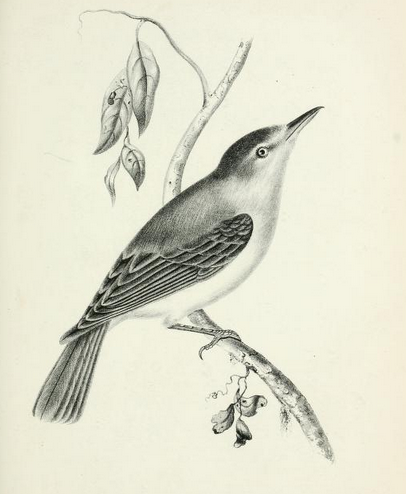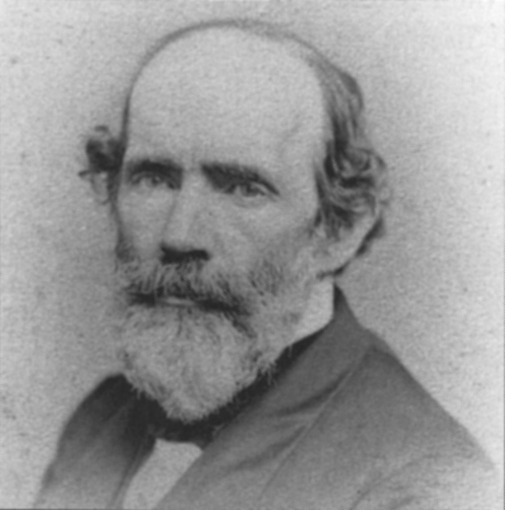John Cassin’s Vireos
It’s been going on for six weeks now, but these first days of September see the southbound migration of songbirds in full swing. And all up and down the east coast of North America, birders are taking to the field in search of little brown birds and little green birds and little greenish-brown birds.
It was no different in the early autumn of 1842. On a fine September morning, the 29-year-old John Cassin set out for Bingham’s Woods, then and now—as part of today’s Fairmount Park—one of Philadelphia’s favorite birding playgrounds. It’s unlikely that Cassin, the bicentennial of whose birth in Delaware County, Pennsylvania, we mark today, was carrying field glasses; but we do know that he had his gun. One of the migrants he shot that day was in the upper branches of a tree of considerable heighth [sic], engaged in capturing insects, and attracted [Cassin’s] attention by its slow and apparently deliberate movements.
He skinned the bird and added it to his private collection, where it lay for the better part of a decade before Cassin—meanwhile Curator, Life Member, and Corresponding Secretary of the Academy of Natural Sciences in Philadelphia—described it in 1851 as the type of a new species, which he named Vireosylvia philadelphica.
That was the first, last, and only Philadelphia Vireo John Cassin would ever see; indeed, “this rare species”, was not found again in Pennsylvania until September 1878, almost ten years after the untimely death of the man who, more than any other student of Natural History in America, ha[d] advanced the science of Ornithology, and whose matured and well[-]cultivated mind enabled him to render cheerfully and generously much assistance to younger students and to institutions of learning in that and other branches of knowledge.
*_*_*_*
In the same article—titled, with characteristic modesty, a “sketch” —Cassin described two more new vireos.
The first, “recognized without difficulty by the very delicate cream color of the entire under surface of its body, which color [he had] never seen in any other bird,” had come to Cassin’s attention in the form of three skins, two from Monterey, California, in the collections of theSmithsonian (now specimens A 3724 and A 3725 and one from Georgetown, California, in the Philadelphia Academy.
The Academy’s skin had been collected and donated by “the far-famed Taxidermist” John G. Bell, “a man of marked personality and ardent enthusiasms” who over his long life was both field companion to the aging Audubon and mentor to the young Theodore Roosevelt.
Bell, of course, already had a vireo named for him, and Spencer Baird, Cassin’s counterpart at the Smithsonian, urged the Philadelphian to name this novum instead after the collector of the specimens now in Washington, William Hutton. Cassin at first resisted:
Calling that Vireo after your friend Hutton is one of the severest things. I don’t want to do it – when he gets better known I will call something after him. This kind of thing is bad enough at best, but to name a bird after a person utterly unknown is worse than that. I do not doubt his entire capability but I don’t like to thrust honors upon him.
Baird, though, ever amiable and ever persuasive, prevailed, and Cassin graciously took “the liberty of naming” the new bird for “Mr. Wm. Hutton, a zealous and talented young naturalist now resident at San Diego, in California.”
Like Cassin’s Philadelphia Vireo, the Hutton’s Vireo remained little known and mysterious for some years after its discovery and description. Not until California observers had figured out how to tell itconsistently from the Ruby-crowned Kinglet was the species’ true abundance recognized.
The third of Cassin’s novae species is based on skins collected by Bell in Panama and by Philippe August de Barruel-Beauvert, a French businessman in Nicaragua.
Abandoning patronyms, Cassin named this “very handsome species” flavoviridis for its “fine yellowish olive” upperparts and “fine greenish yellow” of the flanks and undertail. By 1858, the bird’s known range had been extended to northeastern Mexico, with two specimens taken in Monterrey by Darius Couch of kingbird fame. Twenty years later, the young James Cushing Merrill collected a male on Fort Brown, Texas, the first record of this species in the United States.
*-*-*-*
Cassin himself, of course, lauded by Coues—whose praise was never cheap—as the “Nestor of American ornithology”, was honored by his contemporaries in the names of numerous other birds, among them, inevitably, a vireo.
In 1858, John Xantus, prized by Baird as a collector of “matchless skill and diligence,” described two new birds from Fort Tejon, California; he named one of them Vireo cassinii.
Xantus, one of the more colorful of Baird’s protégés, had been elected—under the name Louis de Vésey—to membership in the Philadelphia Academy in December 1856; according to Harry Harris, Xantus / de Vésey, on his roundabout way from Leavenworth to Tejon by way of New York in March 1857, “found time to attend a meeting … in order personally to acknowledge his election.” Presumably, he and Cassin met then, and they obviously found each other congenial souls: in January 1859, Xantus wrote enthusiastically to Baird that Mr Cassin wrote me a very long & interesting letter, I returned his compliments with a still longer one….
For all his faith in Xantus, Baird harbored some doubts about the validity of the new vireo. Just months after its formal description, he (and Cassin) included the species in their summary of the ornithology of the great Pacific Railroad Surveys, but warned the reader that the bird—still known from only the single specimen—was obviously closely related to either the Hutton’s Vireo or the Blue-headed Vireo.
In 1865, Baird again reviewed Xantus’s type, and this time pronounced himself now inclined to consider the specimen upon which Vireo cassini was based to be only a dull-plumaged, winter skin of V. solitaria, with the under parts tinged with brownish-buff, and the olive shades obscured. I have never seen a specimen killed in eastern North America having this coloration, nor even making a decided approximation to it, but I can find no tangible characteristic of external form to distinguish them.
Not long thereafter, Robert Ridgway sent two new specimensof the vireo back to Washington, collected in Nevada as part of the seventeen-year-old naturalist’s duties on the King Survey. In their 1874 History, Baird, Thomas Brewer, and Ridgway describe those skins as “even more different from true solitarius” than Xantus’s type, and concluded that the Cassin’s Vireo was after all “really distinct, as a variety,” that is to say, as a subspecies of the Solitary Vireo.
So things stood for the next century and a quarter, with the bird once named for Cassin treated as “just” racially distinct from the other big, wing-barred, white-spectacled vireos. In July 1997, however, the American Ornithologists’ Union reversed that venerable taxonomic decision to restore the Cassin’s Vireo to full species status, giving it once again a place in the field guides, the checklists, and birders’ memories.
*_*_*_*
The bird that John Cassin shot in Bingham’s Woods on that long-ago September morning is now officially known as the Philadelphia Vireo. But the species has also had another label: even into the early twentieth century, it was sometimes called the Brotherly-love Greenlet, a charming if straightforward translation of the scientific name Cassin gave his first specimen.
It’s too sentimental for us today, no doubt, and the bland and logical alternative sanctioned by the AOU will prevail forever. But the notion of “brotherly love” recalls not just the city on the Delaware, but the collegial affection and professional respect that bound the great ornithologists and collectors of what Elliott Coues would call, in a deserved tribute to a man “patient and laborious in the technic of his art, and full of book-learning in the history of his subject,” The Cassinian Period.








Leave a Comment